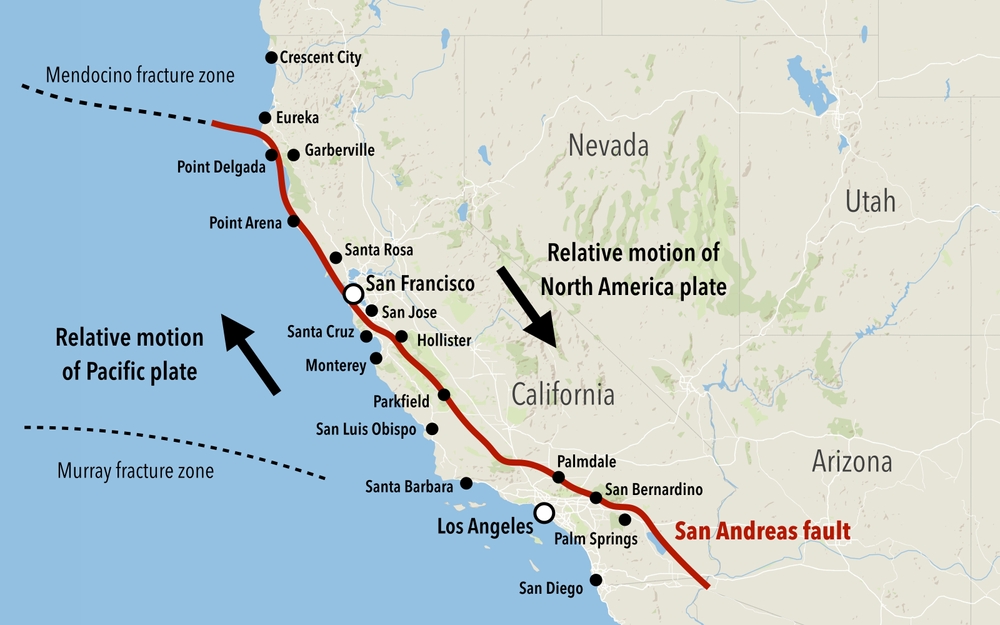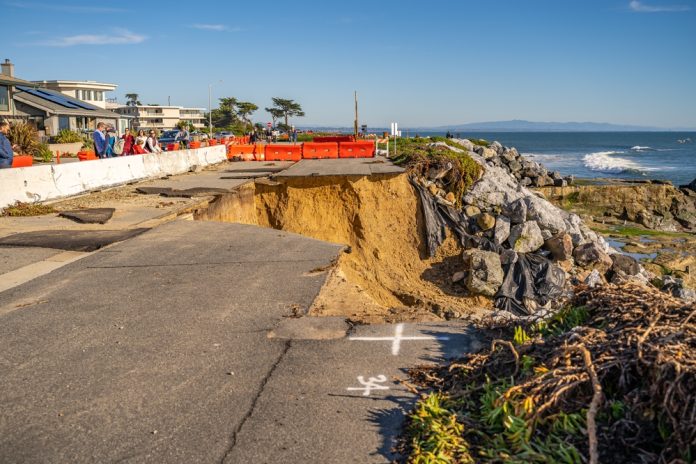“In California, it’s not a matter of if, but when.”
California sits atop some of the most active fault lines in the world. The most popular is the more than 800 miles of San Andreas faults. Up north, you’ve got Hayward and Calaveras faults near the highly populated Bay Area.
California gets hit with daily earthquakes and has two-thirds of the country’s earthquake risk. Yet even with these staggering facts, only approximately 12% of homeowners in California have protection in the form of insurance. Why? The costs associated with insuring against earthquakes are high, and many homeowners simply cannot afford it. Additionally, most standard homeowner’s insurance policies do not cover earthquake damage.
Purchasing your first home in California is an exciting milestone! But as we’ll show you, the state’s reputation for earthquakes should raise concerns. Many out-of-state folks looking at migrating may be unfamiliar with the risks and how to prepare for them. This guide is intended to help first-time homebuyers understand earthquakes in California, the associated risks, and how to make informed decisions to protect their home and family.

Understanding Earthquakes in California
Although California is recognized for its stunning landscapes and vibrant urban settings, it also faces real challenges. The state is located on the Pacific Ring of Fire, a zone of significant seismic activity, and with over 16,000 faults running in and around it, most Californians live within 30 miles of an active fault.

Regional Risks by County
Depending on where you shop, you’ll be exposed to earthquakes differently. Below, we provide an overview of seismic risk in some of the most popular counties. Check a hazard map for the most accurate details. Please note that the following isn’t meant to be exhaustive but serves as an illustration of seismic activity across the state. If your specific location isn’t listed, you may still be vulnerable and within proximity to active faultlines.
Los Angeles County
The most highly urbanized region, Los Angeles County, faces the most risk from faults like the San Andreas, Newport-Inglewood, and Hollywood Faults. The 1994 Northridge and 1987 Whittier Narrows earthquakes are grim reminders of the area’s seismic history. Specifically, areas like Santa Monica, Hollywood Hills, downtown LA, and San Fernando Valley are vulnerable to damage.
San Francisco County & Bay Area

One of the most famous seismic events was the 1906 San Francisco Earthquake. The Bay Area remains a high-risk region; fault lines include the San Andreas and Hayward Fault. The 1906 earthquake, with a magnitude of 7.9, devastated the city, resulting in over 3,000 deaths and destroying 80% of the city. This tragedy led to the tightening of regulations as California implemented rigorous building code reforms.
San Bernardino County
San Bernardino is the largest physical area and faces risks, mainly from the San Andreas and Garlock Faults. The most vulnerable zones include the High Desert- Victorville and Ridgecrest, which frequently experience moderate earthquake activity.
Riverside County

Riverside sits on the popular San Andreas Fault but is also home to the active San Jacinto Fault. Residential and commercial areas near these fault lines are particularly vulnerable.
Orange County
While the San Andreas Fault affects Orange County indirectly, there is still moderate risk, especially those along the borders with Los Angeles and San Bernardino counties.
Additional Notable Regions:
Did we forget to mention where you are currently home shopping? Ventura County, Santa Clara County, San Diego County, and Monterey County all have seismic risks, including landslides and liquefaction. Hilly areas are particularly vulnerable. Double-check a hazard map to be sure you are aware of your exposure.
Protecting Your Home During Earthquakes
Still willing to take the risk? Here’s what you should know as a homeowner in California.
Understand Your Home’s Structural Integrity
Earthquake resistance depends largely on how a home is built. Homes constructed after introducing stricter building codes inspired by past earthquakes, like the 1906 San Francisco earthquake, are generally more resilient. However, older homes require retrofitting, which is expensive. Two main features are foundation bolting and cripple wall bracing; more on that later.
Don’t skip the home inspection; consider hiring a structural engineer to assess your home’s earthquake preparedness and identify any improvements needed.
Earthquake Insurance
Your standard homeowners’ insurance will not cover earthquake damage. However, several options are available:
- California Earthquake Authority (CEA) is the largest provider of residential earthquake coverage. It offers policies covering structural repairs, personal property, and additional living expenses. Premiums for a single-family home usually range between $800 and $1,500, with deductibles ranging from 5% to 25%. CEA also offers incentives for retrofitting, which reduces premium costs.
- Private insurers like Allstate, State Farm, Progressive, and others offer customizable plans with higher coverage limits for personal property and loss of use. Given the higher coverage, these plans will likely be higher than those of the CEA’s offerings, especially in high-risk areas. Costs vary greatly depending on the insurer, the property’s home value, and its proximity to fault lines.
- Rider: A rider or endorsement can be added to your homeowner’s policy to provide earthquake coverage. While it is convenient to do so through your existing insurer, coverage limits are typically lower.
- Deductible Buy-Back Options allow you to reduce your deductible for a higher premium. This helps mitigate your out-of-pocket expenses after an earthquake. Balance the decision of higher annual costs versus a potential one-time event of an earthquake.
- Policy Endorsements cover items excluded in standard plans, such as pools detached structures like gazebos, and patios.
Enrolling in earthquake insurance provides financial protection and peace of mind. Visit the California Earthquake Authority to learn more.
Home Retrofitting
First-time homebuyers looking to purchase an older home should consider retrofitting to improve earthquake resistance. Common upgrades include:
Foundation Bolting: This retrofit secures your home to its foundation. This retrofit attaches the home’s wooden frame to the concrete foundation to help prevent the house from sliding off during seismic activity. Costs for a single-story home range between $3,000 and $7,000.
Steel Bracing: Reinforces short walls (or cripple walls) between the foundation and the home’s first floor. This decreases the risk of a house collapsing in an earthquake. Costs will be $3,000-$10,000 depending on the size.
Chimney reinforcement stabilizes and/or replaces masonry chimneys that are vulnerable to collapse during an earthquake. This is common with older homes that have unreinforced brick or stone chimneys. Depending on the size and type of chimney, the cost will range between $2,000 and $10,000. Complete replacements can cost up to $20,000.
Seismic Gas Shutoff Valves: This mechanism prevents fires caused by broken gas lines by automatically shutting off gas flow during an earthquake. It applies to homes that use natural gas. Note that some utility companies may subsidize the installation cost, which ranges between $200 and $500.
Other improvements can be made, such as roof-to-wall connections, bracing water heaters, and strengthening foundations. Each has its costs, some quite significant. For more information on retrofitting your home, check out the California Residential Mitigation Program (CRMP).
Prepare a Home Emergency Earthquake Kit
Now that you know some of the costs of retrofitting and insurance, you’re closer to moving in! Be sure to have a plan in place and equip your home with an emergency kit that includes the following:
- Non-perishable food and water (enough for at least 3 days).
- Flashlights, batteries, and a radio.
- First aid supplies.
- Essential medication and personal hygiene items.
- Copies of important documents.
Develop an Earthquake Safety Plan
Identify safe spots in your home, such as under sturdy furniture or against interior walls, to use during an earthquake. Practice “Drop, Cover, and Hold” drills with your family regularly to ensure everyone knows how to respond.
Stay Alert
Sign up for earthquake notification and early warning apps like MyShake to receive alerts directly on your mobile phone.
Financial Considerations of Living in an Earthquake Zone
As a gentle reminder, first-time homebuyers can overlook living costs in earthquake-prone areas. We’ve gone into depth, but here are key takeaways:
- Insurance Premiums – Earthquake insurance can increase your housing expenses but is worth the added security.
- Retrofit Costs—Retrofitting older homes can add an upfront cost (estimated between $3,000 and $7,000) but significantly decreases potential repair costs after an earthquake.
- Emergency Preparedness – Budget for supplies, tools, and rebuilding reserves.
How to Make an Informed Decision
Despite the huge risks and the inevitability of “the big one,” proper preparation can help mitigate damage and keep your family safe. Working with knowledgeable real estate agents and inspectors familiar with seismic activity will reveal some unknowns, providing a well-rounded decision. Beyond that, be sure to understand the risk profile for the home’s location and your own. After the purchase, continue proactively investing in structural upgrades and insurance coverage.
California offers an unmatched coastal dreamy lifestyle, but earthquakes are part of the package. With the proper preparation and safeguards, you can confidently purchase your first home here.
Do you have further questions about protecting your home from earthquakes? Connect with local experts and resources, or visit the California Earthquake Authority for in-depth information about insurance coverage.
Stay safe, and here’s to happy homeownership in the Golden State!


